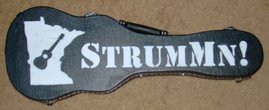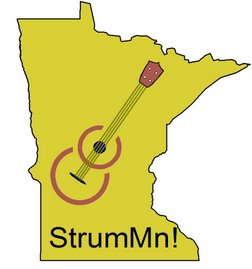Radius dishes are expensive, somewhere on the order of $85 apiece. The wood is about $8.
I built a jig and patterns for 4 different radii; 8ft, 12ft, 15ft, and 25ft. I decided to do the 12ft first. This is a tedious and messy undertaking! Many passes with the router later and a little sanding with the orbital sander and it's looking good!
I think I have a good 2 hours labor in the dish though, not counting building the jig, etc. At least the jig and patterns can be re-used in the future. I'm also making my dishes 24" diameter so they're big enough to do a guitar in the future if I wish.
For those that don't know, radius dishes are used to curve the tops and backs of guitars and ukes.
They can be lined with sand paper to help shape the internal braces, and to sand the top/bottom of the side pieces to match the curve in the top and back, this gives a better glue joint.
The tops and back are also placed in the dish when the braces are glued in, this helps hold everything in place with the correct curve. The dish is placed in a "go-bar" fixture to help with this, google it if you're interested or just wait until I get to that point and I'll include pictures (I have to make it still but their are some freebie alternatives too).
Ready for some pictures?
In this first picture I'm just getting set to start routing. You can see that the router rides on the 2 radiused pattern pieces that just slide into slots at the ends of the jig. The dish turns on a peg in the middle. This is going to take a while and be very loud and messy. I held the router with one hand and the shop vac hose with the other. I also used eye protection, a dust mask, and hearing protection since this took quite a while to complete.

I'm part way done with the routing in the second picture... you can see the dishing under the jig!
In this last one, I've finished routing and sanding. I placed half of the 8ft pattern across the top so you have a straight bottom edge to help visualize the dish. The peg in the middle it to help spin the dish as it's routed. It's a piece of dowel so the router can just cut it too as it goes by. It sticks out more than 1/2" when I measured.
That's it for now.
I hope to see some of you Monday June 23 at Como for some uke playing.
Keep StrumMn this summer!
Brian





3 comments:
Brian -
First, how did your dish turn out?
Second, can you share with me how you made the jig.
I'm a brand new builder with no dough to purchase pre-fab dishes. The sled jig looks super clean and I'd love to build one myself. Thanks for your help.
2nd attempt to reply... I wrote out a long reply, thought I'd posted it, but don't see it now.
Best to email me if you have questions so we don't have to keep coming back to this blog entry.
Do you have specific questions? Look at the pictures, I following similar jigs I saw elsewhere on the web.
I made the long skinny box frame to fit the size of my router and long enough to span my disks. I then put in 2 endblocks on the narrow ends to allow me to slide the different radius patterns into the box frame.
The disks spin on a dowel to keep them centered while I slide the router back/forth on the radius patterns. When done routing I spend 5-10 minutes with a random orbit sander to clean up the disks and then apply sandpaper with Elmers Spray Adhesive.
The radius patterns were made by anchoring a string and running it out to the radius I wanted. Then I wrapped the string around a pencil, lined it up so it would hit evenly on the ends of the wood, and drew my arc. The cut/sand the arc.
You could also draw the arc via computer program and print it out and then transfer to the pattern wood. This would be more accurate but this isn't rocket science and you don't need to be ultra precise on the radius. Just get a smooth curve and it'll work great.
Does this help?
Cool jig, looks alot like this dustless one... http://www.infinityluthiers.com/tutRadiusDish.php
Post a Comment